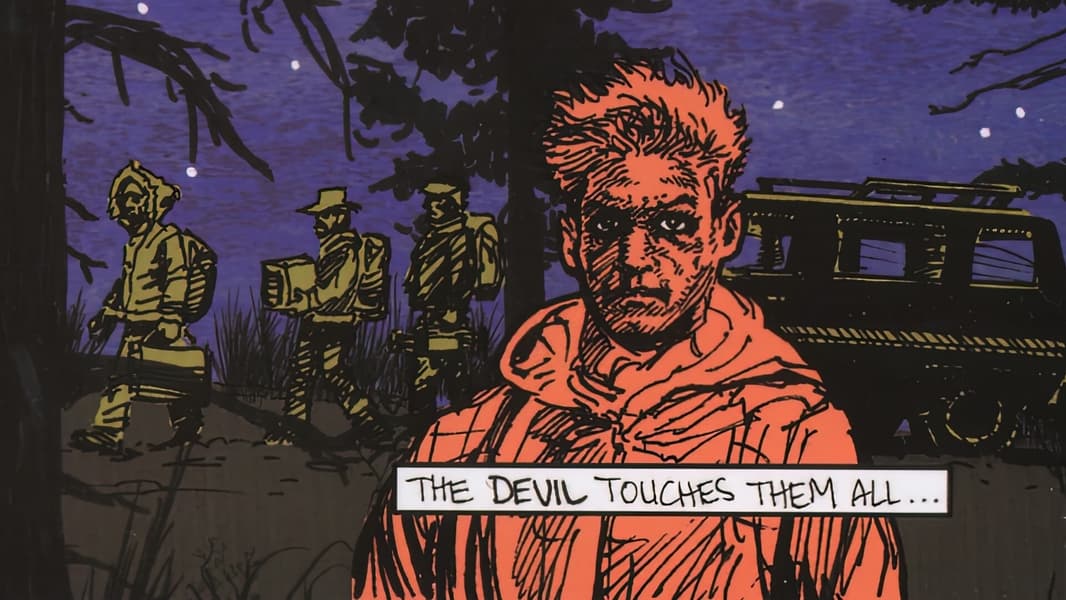
In Extremis: The Last Broadcast (1998) and Circumstantial Evidence
Disclaimer: This is the place I usually do a comedic suggestion to seek independent legal advice before doing something from the film. I am instead giving the uncontroversial opinion that you SHOULD NOT MURDER PEOPLE and DEFINITELY DO NOT FILM A MURDER. With that addressed, please do not rely on this article for legal advice and please note that there are spoilers in this barren analysis.
What can you say about the groundbreaking The Last Broadcast (1998) without immediately mentioning the Blair Witch (1999)? Both are important films in the found footage genre and yet only horror fans have heard of the former. The story features a documentarian, David Leigh (David Beard), telling the story of the murders of Steven Avkast (Stefan Avalos) and Locus Wheeler (Lance Weiler), two hosts of a late night public access show called Fact or Fiction. The film is shot as a true crime documentary that tries to explain what actually happened to the crew of Fact or Fiction in their last broadcast - the film is nothing if not subtle.
But similar to David Leigh, I want to get at the truth of a horror trope that has always frustrated me but I wont be killing anyone to prove my point.
You may have heard in films that the only evidence in a case is circumstantial. This is usually implied as a dismissive critique of the value of the evidence. In this film and other media circumstantial evidence is often accused of creating a paper thin conviction.1
Circumstantial evidence is any evidence that does not directly prove a fact in dispute, but allows the fact finder (either a judge or jury) to make a reasonable determination about the existence or non-existence of a fact based on that piece of evidence. An example of circumstantial evidence is fingerprints in a home. If there are fingerprints of a person that does not live in the home then an inference can be drawn that another person was inside the home at some point. If those fingerprints are on a murder weapon then a further inference could be drawn that the person with matching fingerprint touched the weapon. This does not ultimately prove that they used the murder weapon or further that they committed a murder, but a logical deduction can be made with enough circumstantial evidence that an event occurred beyond a reasonable doubt the burden in a criminal case.
There are other kinds of evidence including direct evidence which is any evidence that directly proves a fact a common example is eyewitness testimony that a crime took place or about the identity of the perpetrator. If believed by the jury then the witness testimony can directly prove a fact such as who committed a murder. The distinction between direct and indirect evidence is not one of completeness. DNA from blood could be direct or indirect evidence that a person was present at the time the blood was taken and that evidence must be interpreted by the jury to determine if it merely suggests the outcome or completely proves it (i. e. are there any other explanations for how the blood got there?).
There is a common misconception that circumstantial evidence cannot be used to convict a defendant of a crime. There is no evidence rule that prohibits a prosecutor from introducing circumstantial evidence or even from solely relying on circumstantial evidence when presenting a case against a defendant. In fact, there may be situations where circumstantial evidence is stronger than direct evidence, especially when the person testifying about what they directly witnessed is unreliable or has been shown to be untrustworthy.2
Now lets contextualise the circumstantial evidence that James Suerd murdered the other Fact or Fiction crew members:
- James was the guide that led them to an area in the pine barrens to record their program the victims and any third party would only know the location by context clues on the livestream;
- James remote internet access stream (which is questionable in the first place, but arguably possible in 1995)3 cuts out for 45 minutes giving him the opportunity to kill the three crew members;
- James is ambidextrous, which is only seen in one percent of the population and the murder appears to be done by a person with two weapons;
- James did a magic trick with ashes on his arm predicting the date they would go into the woods which the prosecution used as evidence of premeditation;
- James has a violent outburst pushing one of the crew when insulted and runs away;
- James is the only crew member that stays behind when the other crew members go to record despite being the guide;
- James made the 911 call that he was not lost but could not find the rest of the crew later that evening;
- James was wearing a shirt with blood stains from all three of the victims on it (the film never explains how that happened or how the real killer could have planted the blood on him).
There are two bodies, no murder weapons found, and a third body missing, but with enough blood to suggest that the third person would have bled to death (dont worry though, the twist is not that Stephen Avkast collected his blood, stored it on ice, and spilled it on the ground to get away with the murders that would be a silly twist from this mystery writers brain puzzle book)4. Furthermore, much is made of the editing done to make James look guilty - however very little behaviour exonerating him is shown in Davids documentary, just pure speculation by other parties about his character.
Shelley Monarch, the magnetic tape specialist, discovers that there is evidence confirming the alibi that two of the victims were alive at the time of death in the prosecutors timeline. She claims this evidence was overlooked/not investigated. A videotape may be considered direct evidence but the chain of custody of the tape (proof of where it came from), proof that it was not altered, and someone to testify to its source would be necessary to ensure its reliability. An appeal would need to be made by Mr. Suerd based on fresh evidence to overturn his conviction.
Viewers should remember that the jury do not have access to the additional tapes, and neither do the police or prosecutor. So when David Leigh calls this a shoddy investigation he is incorrect there are literally no other possible suspects outside of an unknown third party with no direct connection to the crime. As many true crime fans know it can be very difficult to catch a serial killer as apart from DNA and some circumstantial evidence there is no connection to their crimes. In real life it would be ridiculous to investigate a person that sent a chat to speech suggestion online to investigate the Jersey Devil. It would be even more difficult to prove that this chatter was setting up an elaborate frame job, let alone to do so to make a successful documentary about how the convicted party was innocent... so that was naturally the plot of the movie.
I wish to praise this film for generally presenting a plausible case for the innocent party having committed the crime. If not for the additional tapes revealing errors in the prosecution's timeline and photographic evidence of the real killer it was perfectly reasonable for the jury to reach the decision that they did. Davids documentary does a relatively poor job, prior to the introduction of the tapes, of casting doubt on the prosecution or demonstrating that editing was used to misrepresent James actions.
This movie has aged well in many ways, especially with the surge of podcasts and documentaries that question the court process by raising evidence that was inaccessible to the parties or by repeatedly questioning the timeline/evidence offered by the prosecution. It is important to understand that public perception after a court case has the benefit of hindsight and this film portrays this well. So if you want to enjoy a great film, watch the Last Broadcast and turn it off at exactly 1:17:16 (the filmmaking feels like it declined at that point) - but thats just my opinion. Check it out on Youtube or streaming on Shudder today!
- The Last Broadcast (Film) - TV Tropes
- Chapter 3: What You Need To Know About Evidence Introduction to Criminal Investigation: Processes, Practices and Thinking (bccampus. ca)
- Video on the internet in 1995 - see that a live concert was streamed by a band called Severe Tire Damage, but the cost and quality of broadcasting remotely to a television studio without a satellite or radio wired van would be nigh impossible - The Computer Chronicles - Internet (1995) - YouTube.
- 60-Second Brain Teasers Crime Puzzles: Short Forensic Mysteries to Challenge ... - Diane Capri - Google Books
- The Last Broadcast HORROR MOVIE - YouTube

